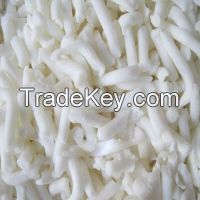Description
Soap noodles are pre-manufactured soap bases that are used as an
intermediate product in the production of various types of soap.
They are made from fats and oils through a process called
saponification, and they provide a convenient way to create
different soap products with minimal additional processing. Heres a
detailed overview of soap noodles, including their properties,
uses, and handling considerations:
### **Properties:**
- **Appearance**: Typically white or off-white, granular or
cylindrical solids.
- **Composition**: Soap noodles are primarily composed of fatty
acids and sodium salts, derived from fats and oils. They may
contain additional ingredients such as surfactants, fillers, and
preservatives depending on their intended use.
- **pH**: Generally alkaline, with a pH ranging from about 9 to *1,
depending on the formulation.
### **Uses:**
1. **Soap Manufacturing**:
- **Base Ingredient**: Soap noodles serve as a base
for producing various types of soap, including bar soaps, liquid
soaps, and body washes. They are melted and mixed with other
ingredients to create finished soap products.
- **Customization**: Manufacturers can add fragrances,
colorants, moisturizers, and other additives to soap noodles to
tailor the final product to specific needs or preferences.
2. **Industrial Applications**:
- **Scale-Up**: In large-scale industrial operations,
soap noodles are used to streamline production processes and ensure
consistency in soap quality.
3. **Personal Care Products**:
- **Private Labeling**: Companies may use soap noodles
to produce private-label or branded soap products with unique
formulations and properties.
### **Handling and Safety:**
- **Skin and Eye Irritation**:
- **Precautions**: Soap noodles can cause irritation to the
skin, eyes, and respiratory tract, especially in powdered form.
Handle them with care and use appropriate personal protective
equipment (PPE) such as gloves, safety goggles, and masks.
- **Ventilation**:
- **Work Environment**: Ensure adequate ventilation when
working with soap noodles to avoid inhalation of dust.
- **Storage**:
- **Conditions**: Store soap noodles in a cool, dry place
away from moisture and direct sunlight. Proper storage helps
prevent degradation and maintains the quality of the product.
- **Disposal**:
- **Waste Management**: Dispose of soap noodle waste
according to local regulations. They are generally considered
non-hazardous waste but should be managed to avoid environmental
contamination.
### **Types of Soap Noodles:**
1. **Sodium Soap Noodles**:
- **Composition**: Made from sodium salts of fatty
acids, these are commonly used for producing solid bar soaps.
2. **Potassium Soap Noodles**:
- **Composition**: Made from potassium salts of fatty
acids, these are used for producing liquid soaps and softer soap
products.
3. **Specialty Noodles**:
- **Additives**: Some soap noodles may include
additional components such as emollients, exfoliants, or
antimicrobial agents to meet specific product requirements.
### **Regulations and Standards:**
- **Quality Control**: Soap noodles must comply with industry
standards and regulations for safety, quality, and labeling.
Manufacturers often adhere to guidelines set by organizations such
as the International Organization for Standardization (ISO) or
local regulatory bodies.
- **Ingredient Transparency**: It is important for manufacturers to
provide transparency regarding the ingredients and additives in
soap noodles to ensure safety and meet consumer expectations.
If you have more specific questions about soap noodles, such as
their formulation, applications, or regulatory considerations, feel
free to ask!
